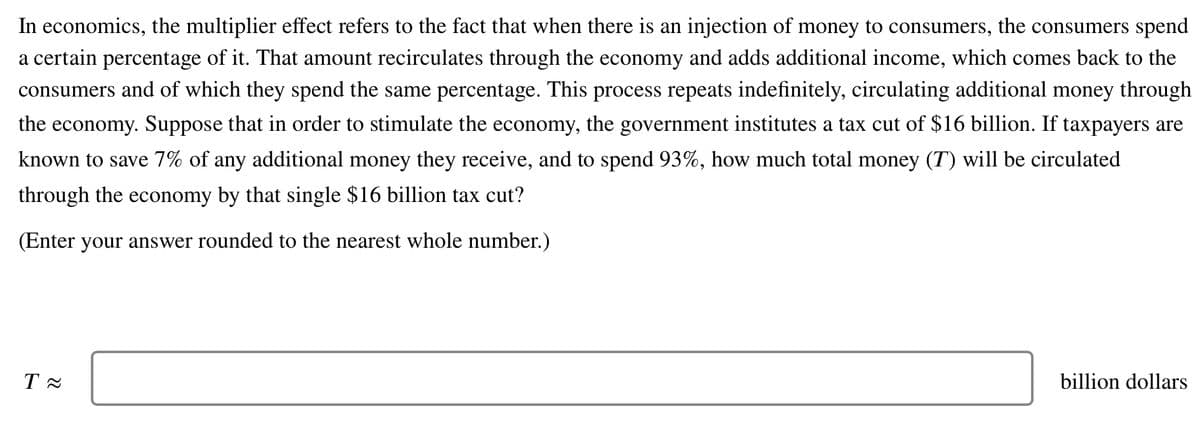In economics, the multiplier effect refers to the fact that when there is an injection of money to consumers, the consumers spend a certain percentage of it. That amount recirculates through the economy and adds additional income, which comes back to the consumers and of which they spend the same percentage. This process repeats indefinitely, circulating additional money through the economy. Suppose that in order to stimulate the economy, the government institutes a tax cut of $16 billion. If taxpayers are known to save 7% of any additional money they receive, and to spend 93%, how much total money (T) will be circulated through the economy by that single $16 billion tax cut? (Enter your answer rounded to the nearest whole number.) T≈ billion dollars
In economics, the multiplier effect refers to the fact that when there is an injection of money to consumers, the consumers spend a certain percentage of it. That amount recirculates through the economy and adds additional income, which comes back to the consumers and of which they spend the same percentage. This process repeats indefinitely, circulating additional money through the economy. Suppose that in order to stimulate the economy, the government institutes a tax cut of $16 billion. If taxpayers are known to save 7% of any additional money they receive, and to spend 93%, how much total money (T) will be circulated through the economy by that single $16 billion tax cut? (Enter your answer rounded to the nearest whole number.) T≈ billion dollars
Chapter11: Fiscal Policy
Section: Chapter Questions
Problem 1.4P
Related questions
Question

Transcribed Image Text:In economics, the multiplier effect refers to the fact that when there is an injection of money to consumers, the consumers spend
a certain percentage of it. That amount recirculates through the economy and adds additional income, which comes back to the
consumers and of which they spend the same percentage. This process repeats indefinitely, circulating additional money through
the economy. Suppose that in order to stimulate the economy, the government institutes a tax cut of $16 billion. If taxpayers are
known to save 7% of any additional money they receive, and to spend 93%, how much total money (T) will be circulated
through the economy by that single $16 billion tax cut?
(Enter your answer rounded to the nearest whole number.)
T≈
billion dollars
Expert Solution
This question has been solved!
Explore an expertly crafted, step-by-step solution for a thorough understanding of key concepts.
This is a popular solution!
Trending now
This is a popular solution!
Step by step
Solved in 3 steps

Knowledge Booster
Learn more about
Need a deep-dive on the concept behind this application? Look no further. Learn more about this topic, economics and related others by exploring similar questions and additional content below.Recommended textbooks for you


Brief Principles of Macroeconomics (MindTap Cours…
Economics
ISBN:
9781337091985
Author:
N. Gregory Mankiw
Publisher:
Cengage Learning

Essentials of Economics (MindTap Course List)
Economics
ISBN:
9781337091992
Author:
N. Gregory Mankiw
Publisher:
Cengage Learning


Brief Principles of Macroeconomics (MindTap Cours…
Economics
ISBN:
9781337091985
Author:
N. Gregory Mankiw
Publisher:
Cengage Learning

Essentials of Economics (MindTap Course List)
Economics
ISBN:
9781337091992
Author:
N. Gregory Mankiw
Publisher:
Cengage Learning

Survey of Economics (MindTap Course List)
Economics
ISBN:
9781305260948
Author:
Irvin B. Tucker
Publisher:
Cengage Learning

Macroeconomics: Principles and Policy (MindTap Co…
Economics
ISBN:
9781305280601
Author:
William J. Baumol, Alan S. Blinder
Publisher:
Cengage Learning
